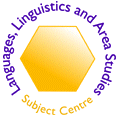
|
|
EuroTalk World Talk RussianAuthors: EuroTalk Interactive http://www.eurotalk.co.uk Review Author: John Wieczorek, University of Reading, February 2002 The Eurotalk World Talk Russian disk is intended for 'intermediate' learners of Russian, and while there is no given age group, many of the texts, as well as the 'hip' TV orientation imply late teens or younger adult learners rather than an older clientele. The initial screen offers the learner the main World Talk program, but also a quiz as well as 'student records'. This quiz is rudimentary (but highly competitive) and is designed to allow two people to compete against each other in responding to a number of visual and verbal prompts/questions on the content of the program as a whole. As almost throughout the whole program, most aspects of this quiz involve a multiple-choice question and answer exercise, with the questions normally vocalised and also presented in writing. The student records are extremely rudimentary, giving simply the students' names and the number of 'points' each has scored while working through the exercises, as well as the number of exercises attempted. The main program consists of a wheel of fortune covering ten areas of vocabulary from which the learner can choose. These areas include weather, numerals, directions, dates, descriptions, food and sport. In all areas the program attempts to maintain the student's interest with a number of lively ideas. The exercise with numerals, for instance, uses the idea of lottery balls. Each has a number and the learner has to click the correct ball in response to a number being spoken. The weather part of the program consists of three windows showing different meteorological conditions, while a voice describes one of them The learner then clicks on the correct window. In addition to thee wheel of fortune, the main program offers a listening/dictation exercise comprising six short listening exercises which can be run at different speed and also printed out for comparison, and twelve short interactive dialogues that can be recorded and played back in a virtual recording studio. One of the highlights of the program is an interactive TV quiz competing against a highly animated competitor called Igor, who appears to get faster in his responses the further the quiz proceeds. The TV quiz against this character covers the same material that has been used in the rest of the program and is a useful summarising exercise on which to end. The program is aimed at providing the learner with a wide variety of spoken stimuli to which he or she has to respond, normally through multiple-choice answers. In general the reviewer felt that the level of Russian in most of the exercises was relatively even and was appropriate to the slightly vague figure of the 'intermediate learner'. There were frequent signs of deliberate progression from the simpler to the more complicated. The program has no dictionary or grammar or written back-up. Occasionally the questions can offer a hint, but there is no feedback to explain problems if you repeat an error. It cannot therefore be used as a stand-alone course. It can, however, provide hours of stimulus and is a useful tool for anyone whose Russian is slightly rusty and who wants to listen to a wide variety of Russian vocabulary, spoken by natives at almost native speed, and with simple (and occasionally not so simple) tests associated with the vocabulary heard. As part of a library of Russian resources it could also be a useful tool, one among many, to stimulate students who have studied Russian for a few years and want some light - but pedagogically useful - relief. The reviewer was not aware of any technical difficulties with the program. It was easy to move about, using the symbol of the wheel and using the 'Help' or Instructions icon of a life belt. The text was easy to read, except in the on-screen version of the listening/dictation exercise, where the font chosen was too small. In general the screen was full but not cluttered, except for the interface into the main series of exercises, where the wheel of fortune was surrounded by icons representing all the other activities - written, the recording studio, the TV studio. The colour-schemes were not 'easy on the eye', but the reviewer felt that this might be the result of his not being in the target group that this program appears to be addressing. In general the reviewer found this an extremely pleasant and stimulating program. It cannot replace more formal Russian grammar and idiom teaching, but it provides a useful complementary tool for the aural/oral parts of any course, and since all the exercises are based on a limited number of areas of vocabulary, the program provides considerable internal reinforcement. |
 |
 |